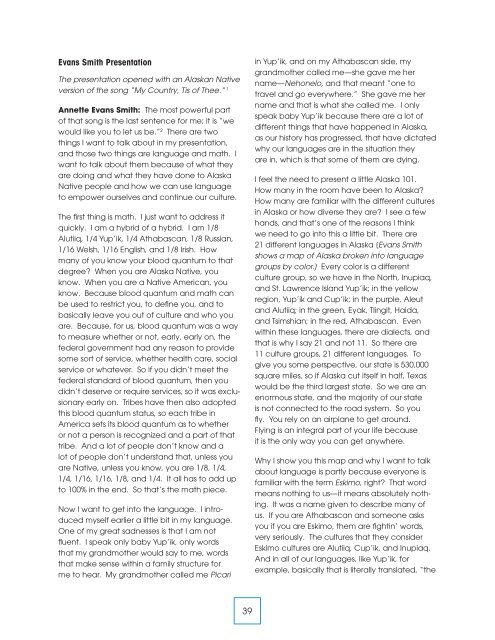The New Face of Arts Leadership in the West - westaf - The Western ...
The New Face of Arts Leadership in the West - westaf - The Western ...
The New Face of Arts Leadership in the West - westaf - The Western ...
Create successful ePaper yourself
Turn your PDF publications into a flip-book with our unique Google optimized e-Paper software.
Evans Smith Presentation<br />
<strong>The</strong> presentation opened with an Alaskan Native<br />
version <strong>of</strong> <strong>the</strong> song “My Country, Tis <strong>of</strong> <strong>The</strong>e.” 1<br />
Annette Evans Smith: <strong>The</strong> most powerful part<br />
<strong>of</strong> that song is <strong>the</strong> last sentence for me; it is “we<br />
would like you to let us be.” 2 <strong>The</strong>re are two<br />
th<strong>in</strong>gs I want to talk about <strong>in</strong> my presentation,<br />
and those two th<strong>in</strong>gs are language and math. I<br />
want to talk about <strong>the</strong>m because <strong>of</strong> what <strong>the</strong>y<br />
are do<strong>in</strong>g and what <strong>the</strong>y have done to Alaska<br />
Native people and how we can use language<br />
to empower ourselves and cont<strong>in</strong>ue our culture.<br />
<strong>The</strong> first th<strong>in</strong>g is math. I just want to address it<br />
quickly. I am a hybrid <strong>of</strong> a hybrid. I am 1/8<br />
Alutiiq, 1/4 Yup’ik, 1/4 Athabascan, 1/8 Russian,<br />
1/16 Welsh, 1/16 English, and 1/8 Irish. How<br />
many <strong>of</strong> you know your blood quantum to that<br />
degree? When you are Alaska Native, you<br />
know. When you are a Native American, you<br />
know. Because blood quantum and math can<br />
be used to restrict you, to def<strong>in</strong>e you, and to<br />
basically leave you out <strong>of</strong> culture and who you<br />
are. Because, for us, blood quantum was a way<br />
to measure whe<strong>the</strong>r or not, early, early on, <strong>the</strong><br />
federal government had any reason to provide<br />
some sort <strong>of</strong> service, whe<strong>the</strong>r health care, social<br />
service or whatever. So if you didn’t meet <strong>the</strong><br />
federal standard <strong>of</strong> blood quantum, <strong>the</strong>n you<br />
didn’t deserve or require services, so it was exclusionary<br />
early on. Tribes have <strong>the</strong>n also adopted<br />
this blood quantum status, so each tribe <strong>in</strong><br />
America sets its blood quantum as to whe<strong>the</strong>r<br />
or not a person is recognized and a part <strong>of</strong> that<br />
tribe. And a lot <strong>of</strong> people don’t know and a<br />
lot <strong>of</strong> people don’t understand that, unless you<br />
are Native, unless you know, you are 1/8, 1/4,<br />
1/4, 1/16, 1/16, 1/8, and 1/4. It all has to add up<br />
to 100% <strong>in</strong> <strong>the</strong> end. So that’s <strong>the</strong> math piece.<br />
Now I want to get <strong>in</strong>to <strong>the</strong> language. I <strong>in</strong>troduced<br />
myself earlier a little bit <strong>in</strong> my language.<br />
One <strong>of</strong> my great sadnesses is that I am not<br />
fluent. I speak only baby Yup’ik, only words<br />
that my grandmo<strong>the</strong>r would say to me, words<br />
that make sense with<strong>in</strong> a family structure for<br />
me to hear. My grandmo<strong>the</strong>r called me Picari<br />
<strong>in</strong> Yup’ik, and on my Athabascan side, my<br />
grandmo<strong>the</strong>r called me—she gave me her<br />
name—Nehonelo, and that meant “one to<br />
travel and go everywhere.” She gave me her<br />
name and that is what she called me. I only<br />
speak baby Yup’ik because <strong>the</strong>re are a lot <strong>of</strong><br />
different th<strong>in</strong>gs that have happened <strong>in</strong> Alaska,<br />
as our history has progressed, that have dictated<br />
why our languages are <strong>in</strong> <strong>the</strong> situation <strong>the</strong>y<br />
are <strong>in</strong>, which is that some <strong>of</strong> <strong>the</strong>m are dy<strong>in</strong>g.<br />
I feel <strong>the</strong> need to present a little Alaska 101.<br />
How many <strong>in</strong> <strong>the</strong> room have been to Alaska?<br />
How many are familiar with <strong>the</strong> different cultures<br />
<strong>in</strong> Alaska or how diverse <strong>the</strong>y are? I see a few<br />
hands, and that’s one <strong>of</strong> <strong>the</strong> reasons I th<strong>in</strong>k<br />
we need to go <strong>in</strong>to this a little bit. <strong>The</strong>re are<br />
21 different languages <strong>in</strong> Alaska [Evans Smith<br />
shows a map <strong>of</strong> Alaska broken <strong>in</strong>to language<br />
groups by color.] Every color is a different<br />
culture group, so we have <strong>in</strong> <strong>the</strong> North, Inupiaq,<br />
and St. Lawrence Island Yup’ik; <strong>in</strong> <strong>the</strong> yellow<br />
region, Yup’ik and Cup’ik; <strong>in</strong> <strong>the</strong> purple, Aleut<br />
and Alutiiq; <strong>in</strong> <strong>the</strong> green, Eyak, Tl<strong>in</strong>git, Haida,<br />
and Tsimshian; <strong>in</strong> <strong>the</strong> red, Athabascan. Even<br />
with<strong>in</strong> <strong>the</strong>se languages, <strong>the</strong>re are dialects, and<br />
that is why I say 21 and not 11. So <strong>the</strong>re are<br />
11 culture groups, 21 different languages. To<br />
give you some perspective, our state is 530,000<br />
square miles, so if Alaska cut itself <strong>in</strong> half, Texas<br />
would be <strong>the</strong> third largest state. So we are an<br />
enormous state, and <strong>the</strong> majority <strong>of</strong> our state<br />
is not connected to <strong>the</strong> road system. So you<br />
fly. You rely on an airplane to get around.<br />
Fly<strong>in</strong>g is an <strong>in</strong>tegral part <strong>of</strong> your life because<br />
it is <strong>the</strong> only way you can get anywhere.<br />
Why I show you this map and why I want to talk<br />
about language is partly because everyone is<br />
familiar with <strong>the</strong> term Eskimo, right? That word<br />
means noth<strong>in</strong>g to us—it means absolutely noth<strong>in</strong>g.<br />
It was a name given to describe many <strong>of</strong><br />
us. If you are Athabascan and someone asks<br />
you if you are Eskimo, <strong>the</strong>m are fight<strong>in</strong>’ words,<br />
very seriously. <strong>The</strong> cultures that <strong>the</strong>y consider<br />
Eskimo cultures are Alutiiq, Cup’ik, and Inupiaq.<br />
And <strong>in</strong> all <strong>of</strong> our languages, like Yup’ik, for<br />
example, basically that is literally translated, “<strong>the</strong><br />
39


